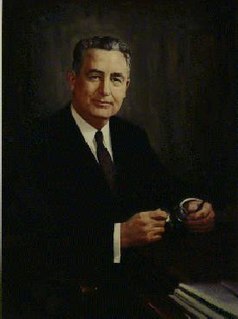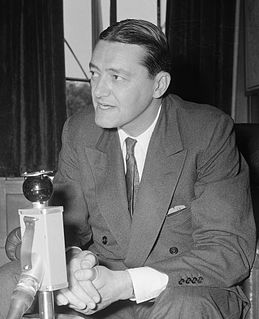
Martin Patrick Durkin was a U.S. administrator. He served as Secretary of Labor from January 21, 1953 to September 10, 1953, where he was the "plumber" of President Dwight Eisenhower's "Nine Millionaires and a Plumber" cabinet.

Milton Stover Eisenhower was an American educational administrator. He served as president of three major American universities: Kansas State University, Pennsylvania State University, and Johns Hopkins University. He was the younger brother of U.S. President Dwight D. Eisenhower.

The White House Counsel is a staff appointee of the President of the United States whose role is to advise the President on all legal issues concerning the President and their Administration. Pat Cipollone has served as the current White House Counsel since December 2018.

James Paul Mitchell was an American politician and businessman from New Jersey. Nicknamed "the social conscience of the Republican Party," he served as United States Secretary of Labor from 1953 to 1961 during the Eisenhower Administration. Mitchell was a potential running mate for the 1960 Republican presidential candidate, Vice President Richard M. Nixon. However, Nixon chose Henry Cabot Lodge Jr. After an unsuccessful run for Governor of New Jersey in 1961, he retired from politics.
Wilton Burton "Jerry" Persons served as the White House Chief of Staff to President Dwight D. Eisenhower from October 7, 1958 until January 20, 1961.

The Eisenhower Executive Office Building (EEOB)—formerly known as the Old Executive Office Building (OEOB) and even earlier as the State, War, and Navy Building—is a U.S. government building situated just west of the White House in the U.S. capital of Washington, D.C. Maintained by the General Services Administration, it is occupied by the Executive Office of the President, including the Office of the Vice President of the United States.

The presidency of Dwight D. Eisenhower began at noon EST on January 20, 1953, when he was inaugurated as the 34th President of the United States, and ended on January 20, 1961. Eisenhower, a Republican, took office as president following his victory over Democrat Adlai Stevenson in the 1952 presidential election. He was succeeded in office by Democrat John F. Kennedy after the 1960 presidential election.

Established by President Dwight D. Eisenhower on 27 June 1957 by Executive Order 10717, the President's Award for Distinguished Federal Civilian Service was created to allow the President to recognize civilian officers or employees of the federal government who have made contributions "so outstanding that the officer or employee is deserving of greater public recognition than that which can be accorded by the head of the department or agency in which he is employed."
Rowland Roberts Hughes (1896–1957) was a director of the United States' Office of Management and Budget from April 16, 1954 until April 1, 1956. Hughes, known for his distinctive black eye patch, was called "the logical man" in a 1956 Time Magazine cover story.
John H. Hamlin graduated from Stanford University with an A.B. in 1929. He was born in Wilkinsburg, Pennsylvania.
Clarence Francis was a business executive and internationally recognized expert on food.

Gabriel Hauge was a prominent American bank executive and economist. Hauge served as assistant to the President for Economic Affairs during the administration of Dwight D. Eisenhower.
Jarold A. Kieffer was the first Executive Director of the National Cultural Center, later renamed the John F. Kennedy Center for the Performing Arts.

Robert Edward Merriam was born in Chicago, Illinois, the son of Charles E. Merriam, and earned an MA degree from the University of Chicago in 1940.
Edward Aenas McCabe was an attorney, a political staffer in the Eisenhower administration, and the founding chairman of the student loans organization Sallie Mae.
Arthur Alden Kimball (1908–1996) was a career civil servant who was part of the prosecution staff for the Nuremberg Trials, and also helped establish the Economic Cooperation Administration for administering the Marshall Plan.
Gerald D. Morgan was born in New York, graduated from Princeton University in 1930, and Harvard Law School in 1933. He was a member of the bar in New York, Kentucky, and the District of Columbia. After his graduation he served in the Solicitor's Office of the United States Steel Corporation for a brief term. Morgan became assistant legislative counsel for the House of Representatives. In 1938, he began practicing law in Louisville, Kentucky, but he returned to his former job in the House in 1939. Between 1945 and 1950, Morgan was a partner in the Washington law firm of Morgan and Calhoun. He worked on special assignments for several Congressional committees, including the House Committee On Un-American Activities.
Anne Williams Wheaton was an American publicist.

Philip Young was an American government official and diplomat who served as United States Ambassador to the Netherlands.











